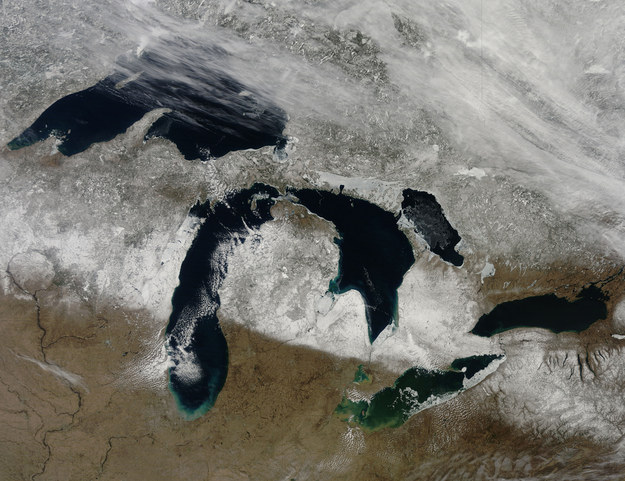
Michigan’s mitt, Jan. 19, 2015. Image: NASA Goddard Space Flight Center
By Kayla Smith
Midwesterners considering a virgin sacrifice to save themselves from frigid temperatures this winter can put down the knife.
The National Oceanic and Atmospheric Administration reports that this year’s El Niño will blow a warm, dry winter over the Great Lakes.
The graphic accompanying the report shows that December through February will bring warmer, dryer temperatures to the Great Lakes region and a wetter, colder winter to southern states.

U.S. winter outlook 2015-16. Image: NOAA
Among the advantages:
Alternative snowmen made from cheese, sand and other non-snow substances may be a big hit. And if you get drunk and fall asleep outside, you are less likely to endure frostbite.
The 2014-2015 winter brought frigid temperatures and hefty snowfall, but thanks to El Niño things will be a little different this year, according to the U.S. Winter Outlook.
The Illinois and Indiana Sea Grant reported that last winter was the second straight year of 80 percent ice cover for the Lake Michigan.
These icy Midwest conditions resulted in local governments spending a ton of money on snow removal, according to the County Road Association of Michigan.
“The harsh winter in 2013-14 caused salt prices to soar for the 2014-15 winter, beyond anything we’ve seen in Michigan before,” said Monica Ware, the group’s communication and development manager.
The price increase was a result of depleted salt inventories. The effects of the price rise were seen across the Midwest, Ware said.
The County Road Association of Michigan serves 83 county road agencies. Revenues for county road agencies have been on a downward slide, while prices of services and resources continue to rise, Ware said. The past two winters have been tough on budgets.
Exhausted snow removal budgets couldn’t afford another snowy winter, even using alternatives deicers like sugar beets.
Salt prices are not secure for the fall yet, but El Niño may allow time for salt producers to get their product out of the ground and stored for harsher winters.
The downside: Certain winter sports may be hurting from a lack of ice.
Fishing spots in the Lower Peninsula may take longer to freeze over, said Jack Horning, the national sales manager of K&E Stopper Lures in Hastings, Michigan.
“First ice can be a tricky time of year, so be sure to take extra steps to insure your safety,” Horning said.
“Such as fish with a buddy, let someone know where you’re going and when you’ll be back. Taking along a life jacket, rope and ice picks is never a bad idea.”
Horning is not too worried about the warm winter. His shop generally makes more profit in the winter on a variety of winter sport apparel and products, he said.
“If you can get ice in West Michigan before Christmas that’s a huge deal,” Horning said.
According to the National Oceanic and Atmospheric Administration, that’s not very likely. El Niño is expected to dry out the Midwest until the spring of 2016.
If it’s too warm in the south, northern lakes will generally develop deep ice more quickly, giving anglers an incentive to travel, according to Horning.
If predictions are correct and El Niño holds out, ice-anglers will have a warm, dry spring to get a jump on summer fishing.